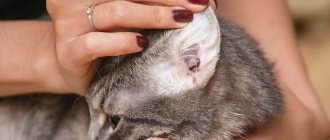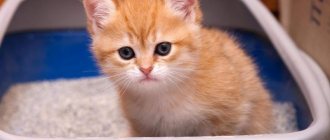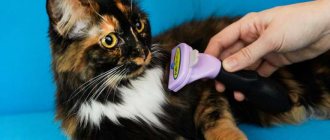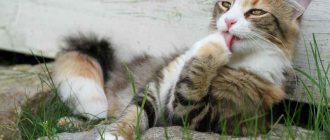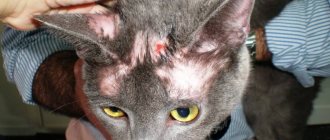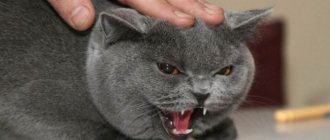Pets, like people, occasionally have digestive problems. The owner of the animal should know how to help the cat if it cannot go to the toilet in a big way. Stagnation of feces is dangerous - it threatens severe intoxication of the body and damage to the intestinal walls. Is it possible to treat constipation in a cat at home, and what medications are allowed to be used? Read on.
Kitten in a tray
Reasons why a cat cannot go to the toilet by and large
Any disease has its causes and consequences. If you do not react in time to the manifestation of symptoms of problems with bowel movements in a cat, then he will get worse, he will suffer and may die from intoxication.
The cat can't go to the toilet
Important! You can't expect everything to go away on its own. At the first appearance of symptoms, it is necessary to take measures to eliminate them.
How many days can an adult cat and kitten not walk?
Minor delays in defecation in cats should not cause concern, as they are not chronic. But in the case when the cat cannot go out for more than 3 days, it is necessary to take urgent measures.
If the cat is young or is still a kitten, then you should pay attention to its condition if it does not go to the toilet for more than 36 hours.
Main causes of constipation
Cats normally have a bowel movement every day or every other day. Small kittens have a faster metabolism, so they walk more often, up to 2 times a day. Constipation is the absence of bowel movements for 2 or more days or difficulty passing stool. Problems with stool usually occur in older animals, but young animals often suffer from them.
Causes of constipation in cats:
- Errors in nutrition - lack of animal proteins and fiber in food.
- Insufficient fluid. If your pet eats dry food and doesn't drink enough, he may have difficulty defecating.
- Ingestion of foreign objects into the digestive organs - bones, fragments of toys, wool.
- Helminthiases. With helminthic infestations, problems with stool are noted - diarrhea can alternate with constipation.
- Neoplasms in the intestines. Hernia and various types of tumors - cysts, polyps prevent food from moving to the rectum.
- Hormonal imbalance.
- Stress. Some cats do not go to the toilet for 3-4 days after moving to a new place, separation from their former owner, or a long car trip.
- Medicines. Constipation in cats occurs when taking antibiotics due to a violation of the microflora. Antihistamines and diuretics also cause bowel problems.
- Pain during defecation due to an inflammatory process developing in the anal glands or rectum.
- Sedentary lifestyle, obesity.
- Pancreatitis - inflammation of the pancreas is often accompanied by constipation.
- Behavioral factors. Clean cats refuse to go into a dirty litter box. Also, some pets do not like the smell of the litter, and they try to use the litter box as little as possible.
Obesity is one of the causes of constipation in cats
Sometimes constipation occurs in domestic cats after sterilization and other surgical interventions. These are usually the consequences of anesthesia. In this case, it is better to take your pet to a veterinary clinic, where he will receive professional help. Stool retention or diarrhea often occurs after deworming. This is normal, the stool will improve within 2-3 days.
Factors causing the problem
Disorders of the gastrointestinal tract in cats can be identified by the following signs:
- stool is too dry or too runny;
- the color of the stool is different from the standard dark brown;
- foreign objects in stool.
A cat poops blood when it goes to the toilet for the most part
Constipation is divided into several categories:
- inherently: organic and functional;
- by patency: full or partial;
- by signs: pain or tension.
The cause of problems with bowel movements can be anything. The main thing to remember is that constipation is not a symptom, but an independent disease.
Factors that can trigger delayed bowel movements include:
- unbalanced nutrition - lack of necessary vitamins and microelements in the feed, excess carbohydrates;
- excess and accumulation of hair in the gastrointestinal tract: sometimes hair does not leave the cat’s body and accumulates in the intestines;
- foreign objects in the gastrointestinal tract: small bones and other objects most often get stuck in the intestines, which prevents the passage of feces;
- various pathologies: inflammatory processes, serious diseases of the gastrointestinal tract, cardiovascular and genitourinary systems;
- tumors in the genitourinary system;
- diabetes mellitus, obesity, urolithiasis;
- the presence of worms;
- infections;
- stress.
After childbirth
Some cats have a decreased appetite before giving birth and go to the toilet frequently. This is due to the pet’s subconscious attempt to “cleanse” the body before giving birth. After giving birth, cats may not defecate for up to three days. This happens because the cat loses a large amount of fluid while feeding kittens.
Important! In case of postpartum constipation, the cat should be helped to defecate by adding Vaseline or vegetable oil to the food. If this does not help and the cat does not go to the toilet for a day, then you need to contact a veterinarian.
After castration
The postoperative period is quite difficult for pets. After castration (sterilization), the animal is prohibited from adding any oil to the food. Such supplements are absorbed into the body very quickly, and castor oil can generally cause severe stomach upset.
Cat after surgery
Important! In addition to regular treatment of sutures and their proper removal, it is necessary to monitor your pet’s stool. Your cat may experience constipation or diarrhea.
After surgery, bowel movements should pass within three days. A pet can defecate largely unnoticed, little by little. The animal needs a soft diet after castration (sterilization), which will not strain the abdominal wall. Otherwise, there is a risk of seams coming apart.
The main reason for problems with bowel movements after surgery is the anesthesia. The animal takes it hard and takes a long time to come to its senses. In addition, the process of bowel movement in the first days after surgery is painful.
How to train a kitten to use the litter box
Successes may not happen on the first day. Some animals take several attempts to understand.
How to teach a kitten to go to the litter box, rules and methods:
- At first, it is common for a kitten to make mistakes when choosing a toilet. Move his affairs to the tray, take the pet there and let him sniff. Let understanding be developed by smell. And treat the place where the cat illegally peed with a repellent spray or scented product.
- If you catch a fluffy in the act of a crime, you can lightly scold him and lightly slap him on the nose with your finger. You can scold a kitten only in this way and strictly during the first seconds after it relieves itself in the wrong place. Scolding your pet near the potty is highly discouraged: he may misunderstand you and forget the way to his toilet forever.
- If the cat resists and prefers the doormat to the litter box, try spraying it with water from a spray bottle. Again: the method only works in the first few seconds. After an hour, the pet will not understand why he was punished, and a purebred cat may be offended for a long time.
- There are special sprays on sale for litter box training. You just need to sprinkle the pot with them. The smell of the product will attract the kitten.
- As soon as the fluffy one manages to determine the place for the toilet, praise him. Do not remove wet litter and “piles” immediately: let the animal get used to the fact that this is where the products of its vital activity will be located.
Advice! It is recommended to take a kitten home from the age of 3-4 months. The baby is already able to learn and obey those who are stronger.
Why doesn't my little kitten poop?
The cat has hot ears: what does this mean?
Month-old kittens go to the toilet quite often (up to six times a day). Kittens are very small and the process of their bowel movements depends entirely on the mother cat. She teaches them this, and monitors their nutrition and stool. If the cat does not take good care of the baby, the kitten will not be able to go to the toilet.
Kittens go to the toilet
In addition, sometimes problems with bowel movements in kittens can be associated with a rare congenital pathology.
The process of defecation is also affected by a sharp change in diet, place of residence, and lack of mother's milk. When moving, you should panic only if the kitten does not go to the toilet for more than five days.
Toilet training process
The little kitten goes to the toilet quite often and can't stand it. The owner will have to learn to determine when he wants to do his business. As soon as the baby begins to squat, he should be calmly transferred to the tray. If suddenly the kitten manages to make a puddle, it should be wiped with a strong odor-repellent agent.
A cat litter box without litter and with one mesh is, of course, convenient for the owner, it is easier to clean and no money is spent on it, however, it can be difficult to immediately accustom a kitten to the litter box for the reason that the cub does not understand what they want from him.
Under natural conditions, animals relieve themselves on the ground or in the sand, and then bury them. You can imitate natural conditions if you use bulk filler. The kitten will be happy to dig into it and this will help make it stop going to the toilet in other places.
Additionally, when the process of accustoming to a place occurs, you can use a special spray. Please note that there are two types of training aids:
- Repellent. They have a strong aroma and mask the smell in the place where the kitten went.
- Attractive. This spray is sprayed directly into the cat's litter box so that habituation in the apartment takes place as quickly as possible.
Usually, training a kitten to use a litter tray is not difficult. Cats are clean animals and get used to going to one place, but for the pet to get used to it quickly, this place must be comfortable.
Signs and symptoms of constipation in a cat
Why does a cat walk past the litter box: the main reasons and what to do
Many pet owners do not immediately notice the symptoms of problems with bowel movements in their cats. However, changes in behavior are fairly easy to recognize. The main symptom is that the cat does not poop for a long time. It is worth clarifying that kittens, in principle, go to the toilet more often than adults. However, an adult cat with a healthy intestine will not tolerate more than three days.
Sometimes, if a cat cannot poop, he begins to attract attention to himself with plaintive meows and restless behavior. Additionally, your cat's belly may be hard and swollen.
Why can't a cat go small?
The complete absence of urination in an adult animal is due to blockage of the tubules. Theoretically, this could happen, for example, due to the formation of adhesions as a result of prolonged cystitis or acute inflammation of neighboring internal organs, but most often the problem lies in urolithiasis. In such cases, the ducts are blocked by stones, sand and blood clots formed as a result of damage to the mucous membranes. Due to irritation of the internal lining, internal edema occurs, and the tubules narrow even more. Similar symptoms in most cases are observed when stones pass through the ducts. Lack of urination with urolithiasis is more common in cats, because the urethra is wider in cats.
In cats, when passing through small stones or sand, as well as in cats, the possibility of emptying with urolithiasis remains, but the urine becomes bloody or the color of meat slop
In kittens, delayed bowel movements can also be associated with pathologies of internal organs, congenital anomalies and inflammation, but usually the symptom occurs due to a banal lack of reflex. The mother helps babies defecate when they lick their bellies. Due to stimulation by the rough tongue, the muscles relax, and the contents of the intestines and bladder freely leave the body. At first, the cat licks the feces, so the owners may think that the kitten is not relieving itself. The most characteristic sign of lack of urination is an enlarged abdomen.
If the owner is convinced that there is a problem or doubts arise, it is better to play it safe and help the baby. You need to take a coarse cloth, gauze, cotton swab or any other material with a similar texture. It is moistened in warm water (about +39°C), then the kitten’s belly is massaged first, then the groin and anus area. This will cause the muscles to relax and release urine and feces if the intestines and bladder are full.
Video: how to help a small kitten go to the toilet
How to help a cat with constipation at home
If a cat can’t go to the toilet for the most part, what should you do? You can help your pet with constipation on your own. To do this, you need to add a small amount of vegetable or petroleum jelly to the food. Mild laxatives are sometimes used in small quantities.
Important! You can also prepare a solution for oral administration with your own hands: boiled water with condensed milk. Such a mixture will help your pet in the early stages of developing problems with bowel movements, i.e. in the first two days. If the cat continues to not go to the toilet for a long time, you need to contact a veterinarian.
Solutions to the problem at home
When the problem is identified, you need to immediately begin taking the necessary measures. Treatment should correspond to the cause of the absence of feces, but if it is not established, constipation must be dealt with directly. It is not advisable to give laxatives on your own, only after consultation with a veterinarian, because if the cat does not go to the toilet due to a tumor, adhesions, hernia or other organic pathologies, they will not be effective and will provide the pet with even more discomfort.
What should you do if your cat is constipated? Several recommendations for combating pathology:
- For a small kitten, if the belly is not bloated, you can massage the tummy. They do not yet have a fully formed digestive system and the mother cat licks her babies, relaxing their tummies. You need to massage gently, without pressing too hard from top to bottom.
- For adult cats, add about 5 drops of Vaseline or vegetable oil to their food. It has a softening effect and helps stool pass out.
- Mix water and condensed milk in a 1:1 ratio and give no more than 5 times a day, no more than every 1 hour. This mixture will help the masses pass through the gastrointestinal tract.
- Using an enema. At home, this is extremely dangerous, you can damage the rectum, so it is better to seek help from a specialist.
- If a cat is pregnant, you cannot do without a veterinarian, because it is impossible to distinguish between pathological constipation in pregnant women and physiological constipation before giving birth on your own.
- Probiotics help animals. They are recommended to be taken; in any case, they help restore normal intestinal microflora.
Some activities do not help, but rather, on the contrary, make things worse for the animal. If a cat has no appetite, you should not force him to eat or drink. Medications must be appropriate to the weight and age of the pet, so it is better to consult a veterinarian.
Help for constipation in hospital
When an animal arrives at a veterinary clinic, it is given a full examination. The veterinarian examines the pet visually and also conducts all necessary tests, ultrasound, etc. Usually a general blood test is enough to understand that the cat cannot go to the toilet due to an inflammatory process and what to do to improve the functioning of the cat’s gastrointestinal tract.
The process of defecation is as important for the stable functioning of the animal’s body as its nutrition. Under no circumstances should you leave a cat that cannot go without attention. Before contacting a veterinarian, you should prepare answers to questions about your pet’s diet, drinking regime, general health, how many days the cat has not pooped, etc.
What to do if the kitten cannot go to the toilet, the kitten is constipated
If you notice
If
the kitten was unable to go to the toilet , in such a situation it is necessary to understand that he needs help. If this continues for 4 days, then you should act immediately
.
- First, feel his stomach. This is done in order to understand whether he is in pain, and whether there is bloating. If after pressing he meows, then the diagnosis is confirmed. If you cannot or are afraid to carry out such actions yourself, then you need to call a specialist from a veterinary emergency center to your home. It is best for the veterinarian to come to you, and not for you to come to the center. This will be much safer for the animal, since the kitten already feels bad, and if you drive it around the city and shake it, it will only get worse.
- The specialists of the veterinary emergency center are highly qualified veterinarians with extensive experience who will make the correct diagnosis of your pet and prescribe effective treatment. In addition, the cost of services is quite reasonable.
- Remedies that will help a kitten with constipation:
- Vegetable oil is one of the most effective remedies that will relieve your pet of constipation. It can be used for both small and large animals. Just half a spoon a day will be enough and the intestines will work as they should.
- Naturally, the animal will not drink it on its own, so you need to draw the oil into a syringe, remove the needle and pour it into the pet’s mouth. Then give him some water to drink. You can also mix vegetable oil with food. But this is only if the animal is not particularly picky.
- A bar of soap is also a way to relieve your kitten from constipation. You need to take a small piece of soap, moisten it with water and lightly insert it into the anus. Naturally, the procedure is not pleasant, so it is best to carry out it when the animal is in a sleepy state. The result can be seen in a couple of hours.
- Another remedy is an enema, one of the most difficult. For this procedure, you need to boil water, and when it cools down, draw it into a syringe. Then introduce water into the anus slowly and carefully.
If all these methods do not help, then you need to contact a veterinary emergency center, where a specialized specialist will prescribe the necessary medications in order to bring the kitten’s body into complete order. You should not self-medicate, as this can only harm the animal.
Enema appointment
In severe cases, when visiting a veterinary clinic, the doctor recommends the use of an enema. The cleansing process takes place under the supervision of doctors in the clinic in the following sequence:
Healthy cat
- an hour and a half before the procedure, the animal takes 3 ml of vaseline oil;
- Next, prepare an enema solution at room temperature;
- the tip is lubricated with Vaseline oil, the solution is drawn up and inserted into the cat’s anus in a circular motion;
- At the end of the procedure, the pet’s anus is clamped with the tail for 20 minutes and only after that the animal is released to the toilet.
It is necessary to understand that douching is a very painful and unpleasant procedure for the animal. It is prohibited to carry it out if the pet has skin disorders around the anus, as well as bleeding and cardiovascular diseases. In addition, douching is not performed on pregnant cats.
Important! Frequent enemas disrupt the intestinal microflora and injure the pet's anus.
Diet to prevent constipation
For stable operation of your pet’s gastrointestinal tract, it is necessary to give him food that is enriched with protein and fiber. Completely eliminating cheese, dairy and flour products, eggs and rice from your cat’s diet will help reduce the risk of developing problems with bowel movements.
The animal needs constant access to a drinking bowl with clean drinking water and regular exercise. If the pet is not very active, then it is necessary to play with it to develop the animal’s mobility and to increase the ability to defecate if constipation develops.
Preventing constipation in cats
Preventing problems with bowel movements in cats is much easier than treating their consequences. Preventive measures include:
- regular brushing (especially during molting);
- food that stimulates the removal of hair from the gastrointestinal tract (special food);
- food containing fiber;
- regular availability of clean water in the drinking bowl;
- physical exercise;
- regular examination by a veterinarian;
- regularly self-examine your pet for symptoms of constipation.
Attentive attitude towards your pet, proper and balanced nutrition can significantly reduce the risk of a cat developing problems with bowel movements and subsequent complications due to this cause.



